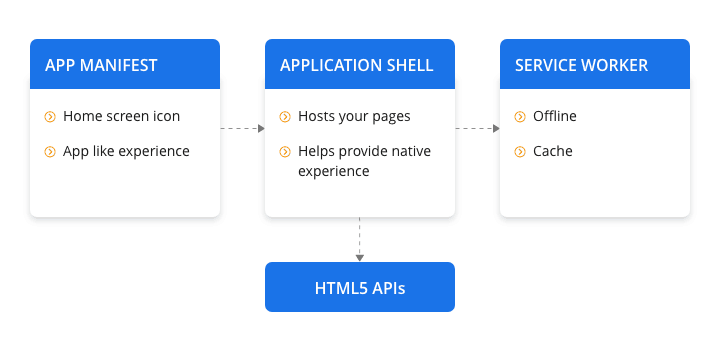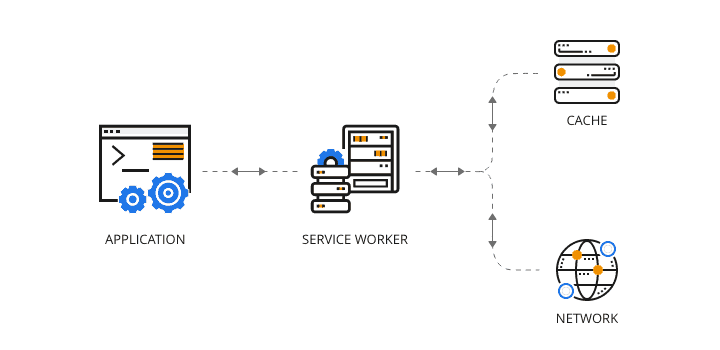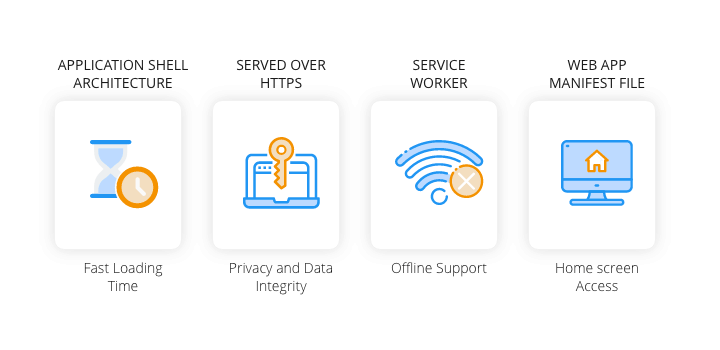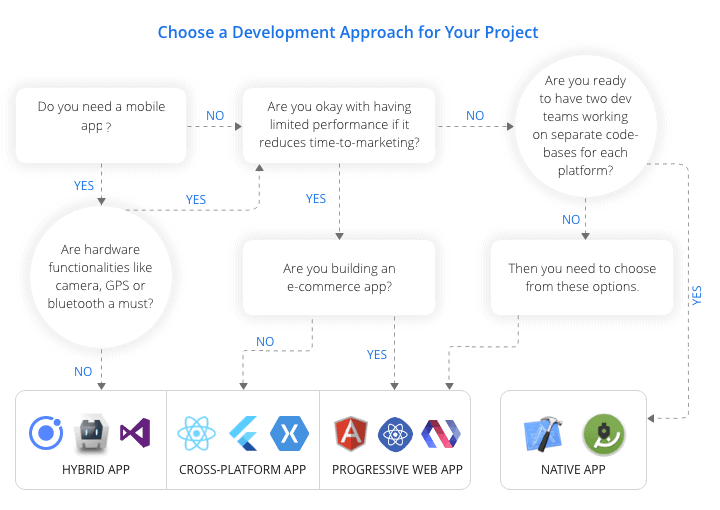Progressive Web Apps (PWAs): The future of mobile web apps
by TechAhead Software Mobile App Development CompanyWhile browsing a website, if you have ever come across a banner saying, “Add to Home Screen”, you will notice that the application installs in the background on hitting the “Yes” button. This application will give you the same experience on your smartphone that you were getting while browsing the website.
You have just downloaded a mobile application from a web app, without having to enter the app store. Not just that, you will be able to browse the contents of the app even when you’re offline. Isn’t it amazing to access an app in offline mode? The experience that you have just come across is the PWA. In simple words, the Progressive Web App development is a website that is similar to a mobile application.
App architecture of PWA
The website interpretation depends upon two main approaches - Server-side rendering and Client-side rendering:
Server-side rendering
The website is rendered on the server to ensure faster loading. Navigation between the web pages requires downloading HTML coding. Quick functionality across browsers is guaranteed; however, loading a new web page requires a round trip to the server.
Client-side rendering
Here, the initial request loads the webpage, CSS, layout, JavaScript and the content. For subsequent updates, all these steps are repeated. While navigating across pages, updates initiate almost instantly. The website may appear slower at first, but the navigation is a lot faster.

Progressive Web Apps can be developed using any of the above approaches. However, App Shell is the most popular concept to build a PWA. App Shell allows loading a minimal user interface and then caching it so as to make it available offline. Apparently, the UI will load much faster on subsequent visits on the same device. The website built using App Shell is interactive, performs faster, and feels like a native app. It is progressive, linkable and responsive by design.
Technical requirements for a PWA
Few technical pre-requisites ensure the successful development of Progressive Web Apps. At a minimum, a website must have a web manifest file, must serve using HTTPs, and must register a service worker. Let’s have a closer look at all three technical requirements for developing a PWA:
HTTPS: Progressive Web Apps must be deployed via a public webserver to ensure complete security of the platform and this can be done following HTTPS protocol.
Service Workers: PWA provides offline access through service workers- a JavaScript file that serves as a link between the app and the network.

App Manifest: One of the core technical requirements for developing PWA. The app manifest is a JSON file that gives information about the PWA with the browser.
Also Read:
Best frameworks to build your Progressive Web Apps (PWA)
Key features of Progressive Web Apps (PWAs)
Progressive Web Apps (PWAs) are designed and developed to load instantly a deliver an excellent user experience. An app that loads faster ensures better customer retention and an increased conversion ratio. Businesses in all different domains are adopting PWA due to its high-performance capabilities. Several must-have features of PWA are as follows:
Offline access
User experience, most of the time is influenced and undermined by unreliable connectivity issues. PWA is accessible even if you lose internet connectivity. It means that you can view the stored data by accessing the site offline.
Progressive
Progressive Web Apps utilize the right capabilities at the right instance of time to create and deliver a delightful experience. Built as per progressive enhancement guidelines and principles, these apps offer basic functionality to everyone, regardless of the browser.
Enhance user engagement
PWAs engage more customers due to its high discoverability, frictionless, responsive and easy to discover attributes. These apps load faster and work flawlessly to engage more customers.
More secure and faster
These apps work over HTTPs and ensure maximum privacy and security to users as well as to the website data. Secure connectivity prevents sensitive information from unauthorized access and other vulnerabilities.
Responsive
Progressive Web Apps are responsive as they work on all screen sizes. These apps are compatible with different operating systems and are highly accessible over different devices- be it a mobile phone, tablet, desktop, laptop, etc.
SEO-friendly
PWAs can be easily indexed by search engines and are SEO centric. It provides some great benefits in terms of customer acquisition and visibility. It’s not easier, but quite simpler to optimize progressive web apps following custom SEO practices.
Low development cost
Since PWAs are built using advanced development tools and practices, these apps are cost-effective in comparison to native mobile apps. Moreover, you get data privacy, security, zero app complexity, and top of that a cross-platform app at a much affordable price.
Core principles
PWAs behaves and works just like a native app; undoubtedly, these apps offer a seamless experience with integrated functionality. They incorporate top-notch capabilities that make these apps relatively customer-centric. PWAs work on the core principles of reliability, high-performance and improved user engagement.
Reliability
Progressive web applications are reliable as they load on the user device regardless of network connectivity. This means that users can access these apps for viewing the stored data in offline mode, i.e. in case of low or no internet connectivity. Pre-caching the key components eliminates network dependency and ensures reliable customer experience.
Performance
Using PWA, users receive an immediate response to whatever action they perform. More than 50% of overall users don’t prefer browsing a website further if it fails to load within 3 seconds. Once open, the user expects the website to be fast and flawless with no slow responding interfaces, inconsistent navigation or excessive scrolling.
Engagement
Progressive Web Apps resides on the user’s home screen and hence, doesn’t require opening the app store. These apps re-engage users with push notifications and offer an excellent user experience. Since these apps are built using Web App Manifest, they give full control over how the app will look. You can specify the screen orientation, home screen icons, the homepage, etc.
How to build a Progressive Web App
Unarguably, PWA brings a plethora of benefits and functional advantages, you do not require rewriting the application. Any app can be transformed into PWA by adding a few additional layers to programming following steps below:
Add a web app manifest
JSON file shares important information about the app with the browser. This includes details about the icon of the app, background color, name of the app, etc.
Register a service worker
The service workers run in the background as the event-driven worker and act as the liaison or proxy between the application and the network.
Create an application shell
An application shell is the first thing that the user sees; so, it is important to ensure that it loads quickly. It must exist in the index HTML and inline CSS.
Served over HTTPS
HTTPS is mandatory to ensure secure access to the app, use Service Workers as well as to allow installation on the home screen.

How does PWA work?
PWA works on both desktops as well as mobile devices using a single code base across platforms. PWA takes advantage of plugins, a huge web ecosystem, and a larger community and it's comparatively easier to deploy and maintain these applications in comparison to native apps. The app is built using HTML and JavaScript. JS framework allows binding JavaScript models to HTML views.
PWAs vs Hybrid Apps vs Mobile Apps
PWAs, as discussed earlier, are the apps that use modern web capabilities and technologies to deliver app-like experience. Native or mobile applications are the apps that are built using different codebase with the intent to target different platforms. Whereas, hybrid apps are the web pages in the native browser such as WebView in Android app development and UIWebView in iOS app development. Hybrid apps are built using HTML, CSS, and JavaScript.

Why PWAs are the future of web apps?
Many businesses are adopting PWAs for hyper-growth and business productivity. Undoubtedly, PWAs are viewed as the future of web applications and there are proven reasons behind that:
- Offline access
- Seamless integration
- High user engagement
- Cross-platform accessibility
- Easy to fix bugs and errors
- Lightning-fast speed
- High performance
- Native-app flexibility
Also Read:
Why Twitter, Pinterest etc are creating PWAs for hyper-growth?
Wrapping Up
PWAs are crucial to staying ahead in the competition. There are numerous reasons why Progressive Web Applications (PWAs) are gaining momentum in the digital space. With native apps, users experience many problems such as storage space, high data consumption, the cost involved in the development, internet connectivity, and many more.
PWA platforms eliminate all these issues while delivering great user experience, higher accessibility and discoverability on the web, cost-efficient development, cross-platform accessibility and above all offline access to data.
Source: https://www.techaheadcorp.com/blog/progressive-web-apps/
Sponsor Ads
Created on Jun 28th 2022 04:28. Viewed 293 times.



